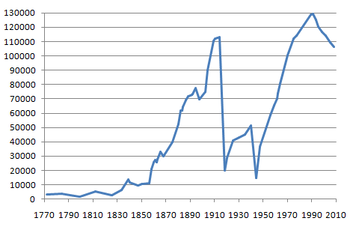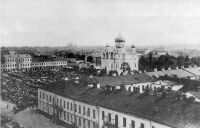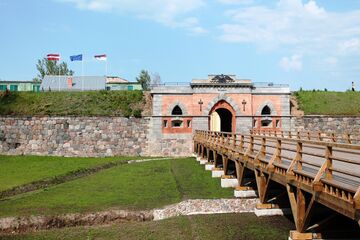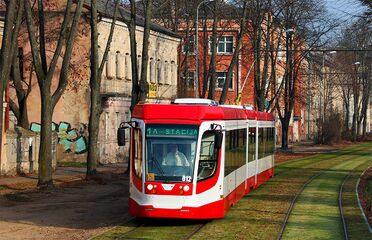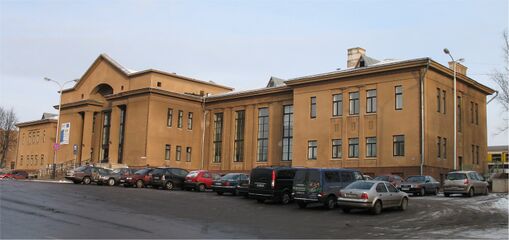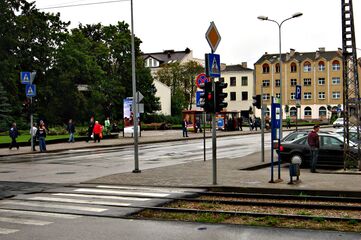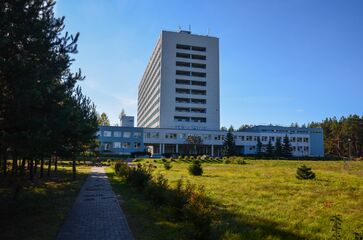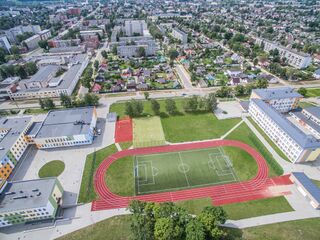داوگاڤپيلس
داوگاڤپيلس
Daugavpils | |
|---|---|
مدينة | |
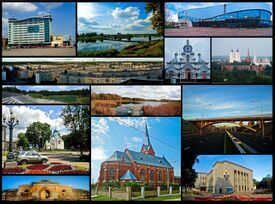 City from different points of view | |
| الإحداثيات: 55°52′30″N 26°32′8″E / 55.87500°N 26.53556°E | |
| البلد | لاتڤيا |
| Established | 1275 |
| Town rights | 1582 |
| الحكومة | |
| • Chairman of the City Council | Igors Prelatovs (Our Party) |
| • Number of city council members | 15 |
| المساحة | |
| • مدينة | 72٫48 كم² (27٫98 ميل²) |
| • الماء | 9٫75 كم² (3٫76 ميل²) |
| أعلى منسوب | 139 m (456 ft) |
| أوطى منسوب | 86 m (282 ft) |
| التعداد (1 يناير 2020)[2] | |
| • مدينة | 82٬046 |
| • الترتيب | 2 |
| • الكثافة | 1٬100/km2 (2٬900/sq mi) |
| • Urban (2017) | 112٬679[1] |
| منطقة التوقيت | UTC+2 (EET) |
| • الصيف (التوقيت الصيفي) | UTC+3 (EEST) |
| Postal code | LV-54(01–65) |
| Calling code | (+371) 654 |
| الموقع الإلكتروني | www |
داوگاڤپيلس (Daugavpils ؛ النطق اللاتڤي: [ˈdauɡaupils] (![]() استمع); لاتگالية: Daugpiļs [ˈdaʊkʲpʲilʲsʲ]; see other names) is a city in south-eastern Latvia, located on the banks of the Daugava River, from which the city gets its name. It is the second-largest city in the country after the capital Riga, which is located some 230 كيلومتر (143 ميل) to its north-west.
استمع); لاتگالية: Daugpiļs [ˈdaʊkʲpʲilʲsʲ]; see other names) is a city in south-eastern Latvia, located on the banks of the Daugava River, from which the city gets its name. It is the second-largest city in the country after the capital Riga, which is located some 230 كيلومتر (143 ميل) to its north-west.
Daugavpils is located relatively close to Belarus and Lithuania (distances of 33 km (21 mi) and 25 km (16 mi) respectively), and some 120 km (75 mi) from the Latvian border with Russia. Daugavpils is a major railway junction and industrial centre and lies approximately midway between Riga and Minsk, and between Warsaw and Saint Petersburg.
Daugavpils, then Dyneburg, was the capital of Polish-Lithuanian Livonia while in Poland-Lithuania. Following the first partition of Poland in 1772, the city became part of the Russian Empire. Since the Second World War, it has maintained an overwhelmingly Russian-speaking population, with Latvians and Poles being significant minorities. Historically, German and Yiddish were additional prominent native languages.
الأسماء
Historically, several names in various languages have identified Daugavpils. Some are still in use today.
- بالبيلاروسية: Даўґаўпілс (Daŭgaŭpils), Дзвінск (Dzvinsk),[nb 1] historically Дынабурґ (Dynaburg)
- الإستونية: [Väinalinn] Error: {{Lang}}: text has italic markup (help)
- فنلندية: Väinänlinna
- ألمانية: Dünaburg
- لاتگالية: Daugpiļs
- لتوانية: Daugpilis
- پولندية: Dyneburg
- روسية: Даугавпилс, Невгин (Nevgin), Динабург (Dinaburg), Борисоглебск (Borisoglebsk 1656–67), Двинск (Dvinsk)
- باليديشية: דענענבורג (Denenburg), باليديشية: דינאַבורג (Dinaburg), باليديشية: דווינסק (Dvinsk)
خط زمني لتغير الاسم
- Dünaburg (1275–1656)
- Borisoglebsk (1656–1667)
- Dünaburg (1667–1893)
- Dvinsk (1893–1920)
- Daugavpils (since 1920)
الجغرافيا
المناخ
The city has a moderate continental climate. Under the Köppen climate classification, Daugavpils features a humid continental climate (Dfb).
| بيانات المناخ لـ Daugavpils | |||||||||||||
|---|---|---|---|---|---|---|---|---|---|---|---|---|---|
| الشهر | ينا | فب | مار | أبر | ماي | يون | يول | أغس | سبت | أكت | نوف | ديس | السنة |
| القصوى القياسية °س (°ف) | 7.5 (45.5) |
13.1 (55.6) |
18.4 (65.1) |
24.4 (75.9) |
30.4 (86.7) |
31.8 (89.2) |
33.6 (92.5) |
31.6 (88.9) |
28.8 (83.8) |
23.6 (74.5) |
16.3 (61.3) |
10.2 (50.4) |
33.6 (92.5) |
| متوسط القصوى اليومية °س (°ف) | −3.8 (25.2) |
−2.5 (27.5) |
2.4 (36.3) |
10.4 (50.7) |
18.1 (64.6) |
21.4 (70.5) |
22.4 (72.3) |
21.5 (70.7) |
16.1 (61.0) |
9.9 (49.8) |
3.2 (37.8) |
−1.3 (29.7) |
9.8 (49.6) |
| المتوسط اليومي °س (°ف) | −6.7 (19.9) |
−5.9 (21.4) |
−1.8 (28.8) |
5.2 (41.4) |
12.1 (53.8) |
15.7 (60.3) |
16.9 (62.4) |
15.9 (60.6) |
11.2 (52.2) |
6.1 (43.0) |
1.0 (33.8) |
−3.8 (25.2) |
5.5 (41.9) |
| متوسط الدنيا اليومية °س (°ف) | −10.0 (14.0) |
−9.4 (15.1) |
−5.7 (21.7) |
0.7 (33.3) |
6.3 (43.3) |
10.1 (50.2) |
11.7 (53.1) |
10.9 (51.6) |
7.2 (45.0) |
2.9 (37.2) |
−1.3 (29.7) |
−6.7 (19.9) |
1.4 (34.5) |
| الصغرى القياسية °س (°ف) | −36.0 (−32.8) |
−34.5 (−30.1) |
−32.0 (−25.6) |
−18.6 (−1.5) |
−5.5 (22.1) |
−0.6 (30.9) |
3.6 (38.5) |
−1.5 (29.3) |
−5.0 (23.0) |
−11.2 (11.8) |
−22.0 (−7.6) |
−38.7 (−37.7) |
−38.7 (−37.7) |
| متوسط تساقط الأمطار mm (inches) | 36 (1.4) |
27 (1.1) |
34 (1.3) |
40 (1.6) |
51 (2.0) |
73 (2.9) |
83 (3.3) |
74 (2.9) |
66 (2.6) |
52 (2.0) |
52 (2.0) |
46 (1.8) |
634 (25.0) |
| Average precipitation days (≥ 1.0 mm) | 9.6 | 7.7 | 8.5 | 8.0 | 9.2 | 9.9 | 11.1 | 10.2 | 11.7 | 9.8 | 11.4 | 11.9 | 119.0 |
| Mean monthly ساعات سطوع الشمس | 34 | 61 | 123 | 170 | 250 | 259 | 255 | 226 | 151 | 90 | 33 | 22 | 1٬674 |
| Source: NOAA[3] | |||||||||||||
الديمغرافيا
As of 1 January 2020, the city had a population of 82,046.[4] In Daugavpils 85% of the voters supported the proposal to make Russian the second state language in the 2012 referendum.[5]
الدين

التاريخ
![]() Grand Duchy of Lithuania 1561–1569
Grand Duchy of Lithuania 1561–1569
![]() Polish–Lithuanian Commonwealth 1569–1772
Polish–Lithuanian Commonwealth 1569–1772
![]() Russian Empire 1772–1917
Russian Empire 1772–1917
![]() Republic of Latvia 1920−1940
Republic of Latvia 1920−1940
![]() الاتحاد السوڤيتي 1940–1941
الاتحاد السوڤيتي 1940–1941
![]() Reichskommissariat Ostland 1941–1944
Reichskommissariat Ostland 1941–1944
![]() الاتحاد السوڤيتي 1944–1991
الاتحاد السوڤيتي 1944–1991

التاريخ اليهودي
Prior to the Holocaust, Daugavpils, (called by its Jewish inhabitants Dvinsk), was home to the most prominent Jewish community in eastern Latvia. The city was already a Jewish center as early as the 1780s and by the time of the 1897 census, they numbered 32,400 (44% of the overall population of the city). By 1911 they had increased to 50,000. The Jews of the town were very prosperous and ran 32 factories and there were 4000 artisans among them.
The city not only boasted a large Jewish population but a rich religious culture including 40 synagogues. The city was home to two of the most prominent rabbis of their time: Joseph Rosen (1858-1936), known as the Rogatchover Gaon (genius from Rahachow), was famed for his commentaries on the works of Maimonides and on the Talmud. Famed for his acidic wit and penetrating genius, he led the towns Hasidic Jews. His 'competitor', the leader of the local Misnagdim (non-Hasidic Jews) was the Rabbi Meir Simcha of Dvinsk (1843-1926). Rabbi Meir Simcha was also renowned for his work on Maimonides (Or Somayach) as well as Bible commentary Meshech Chochma. In one famous comment he predicted that since some Jews had assimilated and viewed Berlin as their 'Jerusalem' they would suffer persecution originating in Berlin.
Another famous Jewish resident was the abstract expressionist painter Mark Rothko. Born in Daugavpils in 1903 he immigrated at the age of 10 to the United States where he painted over 800 paintings in his unique style.
Jewish Daugavpils came to an end following the Nazi German invasion on June 26, 1941. Falsely claiming that the Jews had conspired to set fire to the town and that they were assisting the Soviet army, the Germans and their Latvian collaborators carried out large executions on June 28–29. During July the Jews were enslaved and forced to cut down timber. On July 7–11 Einsatzkommando 1b under Erich Ehrlinger executed many of the remaining Jews. Later in July the 14,000 remaining Jews were forced into a Ghetto along with those from nearby towns. By the end of August an additional 7000 Jews had died at the hands of the Nazis and the local Latvian collaborators. The largest execution took place in November 1941 and was followed by plagues that decimated the few survivors. Only about 1500 Jews remained in the city. These were murdered on May 1, 1942. When the town was liberated in 1944 only 100 survivors remained of a community of 16,000. For more on the Holocaust in Daugavpils see Daugavpils Ghetto.
Art, architecture, and culture
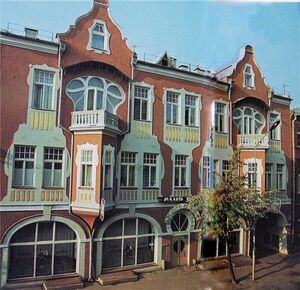
البلدات التوأم - المدن الشقيقة
Daugavpils is twinned with:[7]
 Alaverdi, Armenia
Alaverdi, Armenia Babruysk, Belarus
Babruysk, Belarus Batumi, Georgia
Batumi, Georgia Central Administrative Okrug (Moscow), Russia
Central Administrative Okrug (Moscow), Russia Ferrara, Italy
Ferrara, Italy Harbin, China
Harbin, China Kharkiv, Ukraine
Kharkiv, Ukraine Lida, Belarus
Lida, Belarus Magdeburg, Germany
Magdeburg, Germany Motala, Sweden
Motala, Sweden Naro-Fominsk, Russia
Naro-Fominsk, Russia Panevėžys, Lithuania
Panevėžys, Lithuania Pskov, Russia
Pskov, Russia Radom, Poland
Radom, Poland Ramla, Israel
Ramla, Israel Saint Petersburg, Russia
Saint Petersburg, Russia Vagharshapat, Armenia
Vagharshapat, Armenia Vitebsk, Belarus
Vitebsk, Belarus
معرض صور
Unity House contains Daugavpils Theatre and a recreation centre
Art Nouveau building
Significant depictions in popular culture
- Dunaburg (Daugavpils) is one of the starting towns of the State of the Teutonic Order in the turn-based strategy game Medieval II: Total War: Kingdoms.[8]
See also
Notes
- ^ In Taraškievica it is spelled Дзьвінск (Dźvinsk).
References
- ^ "Population on 1 January by age groups and sex - functional urban areas" (in الإنجليزية). PMLP.gov.lv. Retrieved July 19, 2019.
- ^ "Population on 1 January by municipality". data.csb.gov.lv. Retrieved September 4, 2020.
- ^ "Daugavpils Climate Normals 1961–1990". National Oceanic and Atmospheric Administration. Retrieved November 28, 2015.
- ^ "RESIDENT POPULATION BY STATISTICAL REGION, CITY AND COUNTY". Centrālā statistikas pārvalde. Retrieved 29 May 2020.
- ^ cvk.lv, [1], 18.02.2012
- ^ "Tabula: TSG11-061. PASTĀVĪGIE IEDZĪVOTĀJI PA STATISTISKAJIEM REĢIONIEM, REPUBLIKAS PILSĒTĀM UN NOVADIEM PĒC TAUTĪBAS, DZIMUMA UN PA DZIMŠANAS VALSTĪM 2011.GADA 1.MARTĀ". Data.csb.gov.lv. Retrieved 2013-03-12.[dead link]
- ^ "Sadraudzības pilsētas". daugavspils.lv (in اللاتفية). Daugavpils. Retrieved 2019-08-30.
- ^ "The Teutonic Order (M2TW-K-TC faction)". wiki.totalwar.com. Retrieved 27 November 2019.
External links
| Find more about داوگاڤپيلس at Wikipedia's sister projects | |
| Definitions from Wiktionary | |
| Media from Commons | |
- Information portal (in روسية)
- Information-entertaining portal (in روسية)
 Daugavpils travel guide from Wikivoyage
Daugavpils travel guide from Wikivoyage- Enterprises of Daugavpils
- The murder of the Jews of Daugavpils during World War II, at Yad Vashem website.
- قالب:JewishGen-LocalityPage
- Daugavpils City Government (in إنگليزية)
- Pages using gadget WikiMiniAtlas
- Articles containing بلاروسية-language text
- Articles with dead external links from November 2017
- CS1 اللاتفية-language sources (lv)
- الصفحات بخصائص غير محلولة
- Articles with hatnote templates targeting a nonexistent page
- Missing redirects
- Short description is different from Wikidata
- Coordinates on Wikidata
- Pages with plain IPA
- Articles containing لاتگالية-language text
- Pages using Lang-xx templates
- Lang and lang-xx template errors
- Articles containing فنلندية-language text
- Articles containing ألمانية-language text
- Articles containing لتوانية-language text
- Articles containing پولندية-language text
- Articles containing روسية-language text
- Articles containing يديشية-language text
- Pages using bar box without float left or float right
- Articles with روسية-language sources (ru)
- Articles with إنگليزية-language sources (en)
- Daugavpils
- Cities in Latvia
- Republican cities of Latvia
- Populated places established in the 13th century
- Dvinsky Uyezd
- شتتل
- Holocaust locations in Latvia
- صفحات مع الخرائط




